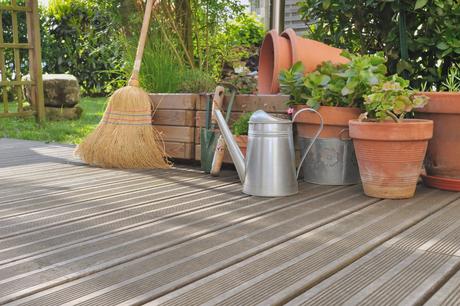
Pest control is an important part of society, particularly in private gardens and large cities. In London, more than 100 rodent complaints are made every day, and although this doesn't mean that you're at risk, it's worth making a few preparations to prevent rodents, birds, and other pests from nesting under your decking and in your garden.
If you're looking for advice and guidance on pest-control, browse our tips for keeping your decking safe from a pest invasion.
Traps and methods of catching pests
Many people choose not to go for this way of handling pest problems, however, there are humane alternatives to lethal traps.
Have you ever considered luring pests out of their safe places with a scent they despise? Apparently, rodents hate the smell of garlic, peppermint and hot spices. So, why not plant a peppermint tree around the edges of your decking or sprinkle cayenne around potential entry points to deter vermin from nesting? Of course, there are also plenty of commercial rat and mice repellents you can buy that will work to keep pests at bay.
If scent-trapping doesn't sound like your thing, you could always invest in a few non-lethal traps to deal with your pest problem. Place these around your decking and make sure to release the rodent at least one mile from your home once caught. But forget cheese; sweet treats work best to lure mice. If you prefer, buy an ultrasonic pest repellent. Compact and discreet, these devices are ideal for placing by your decking and emit high-frequency sound waves that rodents can't stand - and we can't hear.
Making your decking uninhabitable
You're never going to keep on top of pest-control if you make your decking a rodent paradise. Maintaining an area that is always clear of food and rubbish is an essential part of eliminating the chance that you'll attract pests. Keep rubbish and refuse bags tied tightly and placed inside a bin with the lid shut.
If you have a get-together on your decking, make sure you thoroughly clear up and wash the decking so that no sauces or dropped food remain which could entice rodents and other critters. Remember; rats, mice and hedgehogs will also eat birdfeed, so make sure to opt for a birdfeeder that isn't placed on the floor or a table and put it away from your decking.
To be sure that your garden isn't secretly attracting pests, whether it's due to food or shelter, it's wise to get rid of hedges and bushes that can provide homes for rats and mice. If your main pest problem is birds, movement is a great deterrent. Try hanging something that moves - like a wind chime or wind spinner - to help prevent birds from making a mess on your decking.
Creating a decking barrier
Decking comes in a range of styles and designs, which is why the feature is so popular. However, decking typically has sizeable gaps underneath, which could make your decking a haven for unwanted guests. To prevent your decking becoming a rodent housing estate, invest in extra materials to create a barrier.
There's a range of methods and materials you can use to make a barrier underneath your decked space, and we'll look at a few here. We suggest using wood, mesh or chicken wire and running it along the entire edge of your decking between the boards and the ground. If you're worried that this will ruin your decking's aesthetic appeal, you can install a wooden trellis and have the mesh running behind it. Then, arrange potted plants or flowerbeds around your decking to mask the mesh further.
Rodents can get through tiny spaces, so don't leave any gaps.
Woodworm issues and how to deal with them
Perhaps your problem is not with animals under and around your decking, but instead, with pests found inside the decking itself. Woodworm causes headaches for many people and there are three varieties to look out for in the UK. The common furniture beetle is usually what people mean when they say 'woodworm', but the house longhorn and deathwatch beetles are far more destructive - although thankfully rarer.
Time, money and effort goes into treating woodworm, and sometimes, we have to call specialists to deal with the problem. However, if you're looking for prevention methods, the first step is to keep your wooden decking and furniture as dry as possible. This might be difficult for large areas, like your decking, but your tables and chairs should be relatively safe under a waterproof cover. Sealing your wood with varnish is a good shout too. This creates a barrier that prevents female wood-boring beetles from laying eggs in the pores of the wood.
What if you think you have a woodworm infestation and you need help finding treatments? If you can see small holes across your decking and furnishings - these are usually in a cluster and often about 1mm wide - there might be woodworm present. Although this is treatable, you first need to identify which type of woodworm is doing the damage, so it might be worth seeking professional advice. Common furniture beetle problems can be treated yourself using products that you can buy online. However, if the culprits are house longhorn or deathwatch beetles, you may need to treat by injection.
Many experts recommend that people installing new decking in their gardens opt for composite decking, which is due to the fact that this wood won't rot - a good option if you want to prevent woodworm.
Check online for more help and advice on pest-proofing your garden and decked spaces.
Sources:
http://www.harrowtimes.co.uk/news/15700482.Pest_authority_wants_greater_emphasis_on_tackling_rat_issues/
https://www.mercurynews.com/2017/02/08/messy-bird-droppings-ruffling-womans-feathers/
http://www.diydoctor.org.uk/projects/woodworm.htm
https://dengarden.com/pest-control/5-Simple-Ways-to-get-rid-of-Mice-without-Killing-Them
https://www.rentokil.co.uk/blog/rodent-proof-decking/#.WkuPjN9l-Uk
https://www.westernpest.com/pest-control/tips/decks/
